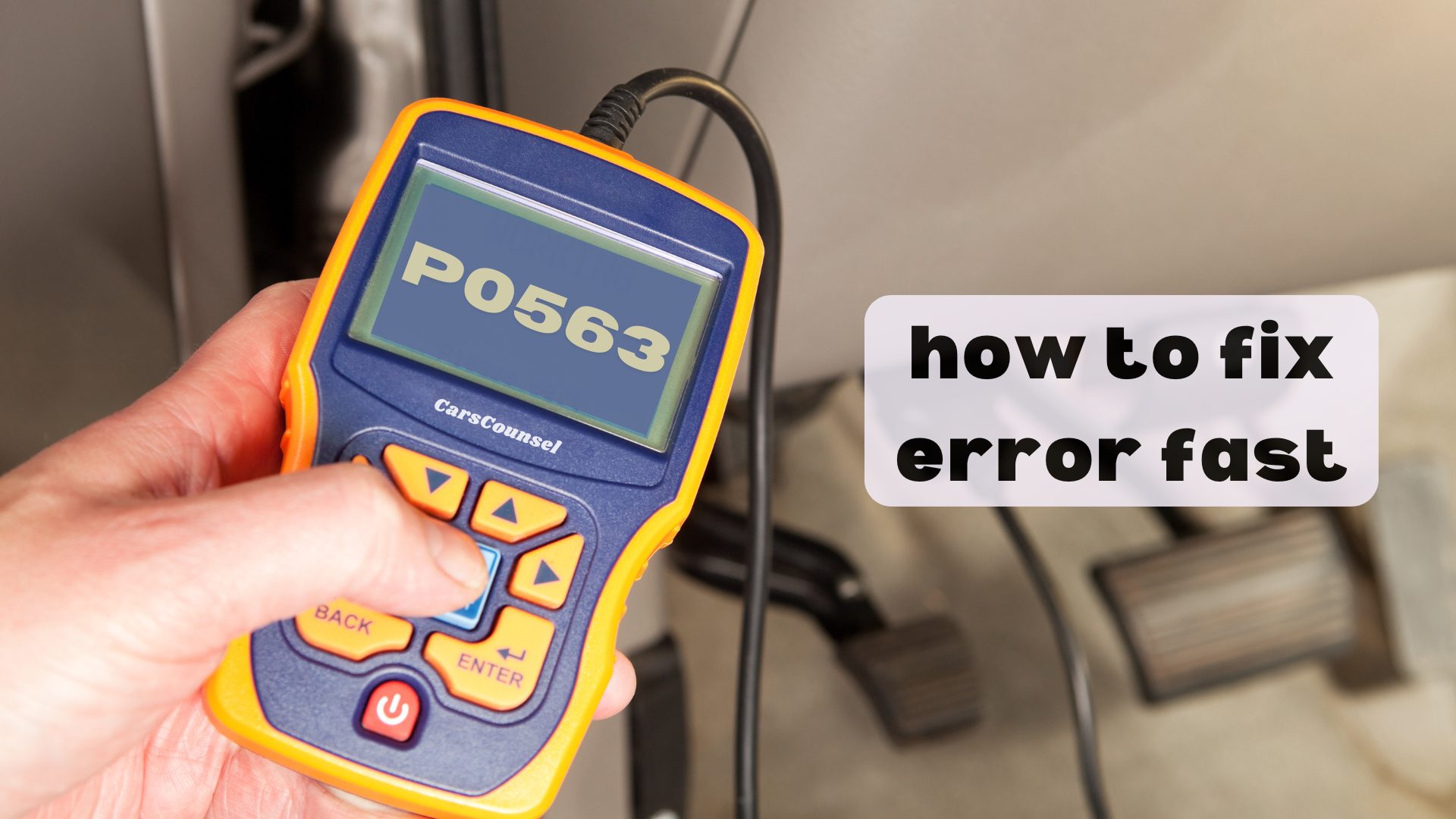Seeing a P0563 code might seem a bit scary, but you can fix it quickly if you follow these steps.
First, use an OBD-II scanner to confirm the trouble code.
Then, check your battery’s voltage with a multimeter. It should read between 12.6-12.8 volts when the car is off.
Next, with the engine running, check the alternator’s output. It should be between 13.5-14.5 volts.
Also, make sure to clean any corroded electrical connections.
If these steps don’t solve the problem, you might need to take a closer look at the alternator or voltage regulator.
Wondering what could be overloading your system?

Quick Navigation
Key Takeaways
- Use a code reader to check if the P0563 code (high system voltage) is showing up.
- Test the battery voltage with a multimeter; it should be between 12.6 and 12.8 volts when the engine is off.
- Check the alternator’s output; it should be between 13.5 and 14.5 volts when the engine is running.
- Look over and clean all electrical connections, making sure the terminals are free from rust and tightly connected.
What Is P0563 Code?
The P0563 code is a common car trouble code that means ‘System Voltage High.’
This usually happens because of problems with your car’s battery or charging system. It indicates that the electrical system’s voltage is higher than it should be, which can harm your car’s performance. This issue can stem from bad batteries, broken alternators, or faulty voltage regulators.
To figure out what’s wrong, start by using an OBD-II scanner to confirm the code.
Check the battery’s voltage; it should be between 12.6 and 12.8 volts when the car is off, and the alternator should put out between 13.5 and 14.5 volts when the car is running.
Also, look at the battery terminals and wiring to see if there’s any corrosion or damage.
Symptoms of P0563 Code
Symptoms of the P0563 code usually show up as warning lights on your dashboard, especially the battery light, indicating a problem with too much voltage in your car’s electrical system. You might also see changing voltage readings or have trouble with electrical features like power windows and lights. Starting your car could become difficult, and electrical parts might overheat.
Here’s a simple table of P0563 code symptoms:
| Symptom | Description |
|---|---|
| Dashboard Warning Lights | Battery light comes on because of overvoltage. |
| Electrical Problems | Issues with power windows, lights, and accessories. |
| Starting Issues | Hard to start the car due to voltage problems. |
Noticing these signs early can help you fix the issue before it gets worse.
Causes of P0563 Code
The P0563 code usually pops up because of a bad battery that can’t keep a proper charge. If you don’t take care of your battery, it can cause voltage drops, which trigger the code.
Alternators and voltage regulators that aren’t working right can also be a big problem because they can’t charge the battery well, leading to voltage swings. Issues with the wiring and connectors in the charging system can mess up voltage regulation too, causing error codes.
On top of that, short circuits in the wiring or badly installed aftermarket accessories can make the electrical system unstable. Extreme temperatures can also affect the battery and electrical system performance, making the problem worse.
Regularly checking and maintaining these parts helps keep the voltage steady and prevents the P0563 code from showing up.
Using OBD-II Scanner
To diagnose the P0563 code, start by using an OBD-II scanner to identify and confirm the error.
Make sure the scanner is up-to-date so it can read the code properly. Plug the scanner into the car’s OBD-II port, usually found under the dashboard.
Turn on the ignition and follow the scanner’s instructions to get the trouble codes. The P0563 code means there’s a ‘System Voltage High‘ issue.
Modern scanners can provide real-time data and freeze frame information, which helps you understand how serious the problem is and its context.
Once you confirm the code, you can move on to more specific diagnostics to fix the root cause. This first step is crucial for a successful repair.
Checking Battery Voltage
To check the battery voltage, use a multimeter to measure the voltage across the battery terminals.
Set the multimeter to DC voltage mode and place the red probe on the positive terminal and the black probe on the negative terminal.
A healthy battery should read between 12.6 and 12.8 volts when the vehicle is turned off. If the reading is much lower or higher, you might have a battery problem.
Regularly checking the voltage can help you catch issues early, ensuring your battery stays in good shape.
Consistent checks can prevent the P0563 code from coming back, saving you future troubles.
Always keep your battery and terminals clean and securely connected to maintain top performance.
Inspecting Alternator Output
To check if your alternator is working well, measure its output voltage while the engine is running. It should be between 13.5 and 14.5 volts.
First, connect a multimeter to the battery terminals. If the reading isn’t in this range, there might be a problem with your alternator or voltage regulator. If the reading is consistently below 13.5 volts, the alternator may not be charging the battery properly. If it’s above 14.5 volts, the alternator might be overcharging. Both situations need immediate attention.
Also, check the alternator belt for tightness and wear, and make sure all electrical connections are secure. Fixing these issues right away will help keep the voltage steady and prevent more electrical problems.
Examining Battery Terminals
Start by checking the battery terminals for any signs of corrosion, looseness, or damage that could mess with your car’s electrical system.
Corroded terminals can stop the proper flow of voltage, leading to the P0563 code. To keep the battery in good shape, clean the terminals thoroughly with a wire brush.
Make sure all the connections are tight and secure to avoid any loose contact issues. After cleaning, apply some dielectric grease to the terminals to prevent future corrosion.
Keeping the battery terminals clean is crucial for ensuring your car’s electrical system works well and for avoiding problems related to high system voltage.
Regularly cleaning the terminals is an easy but effective way to maintain your vehicle’s electrical system and prevent potential headaches.
Fixing Malfunctioning Alternator
When dealing with a broken alternator, make sure you first disconnect the battery to prevent any electrical shorts and safely reach the part.
Start by testing the alternator’s output voltage; it should be between 13.5-14.5 volts when the engine is running. If the voltage is outside this range, the alternator might be bad. Next, check the alternator for any physical damage or worn-out parts.
If the tests show the alternator is faulty, go ahead and replace it. Carefully take off the drive belt and the mounting bolts, then swap out the old alternator with a new one.
Put the belt and bolts back on, making sure everything is secure. Reconnect the battery, start the engine, and check the voltage output to make sure the repair was successful.
Repairing Electrical Connections
After swapping out a bad alternator, ensure you fix any faulty electrical connections to keep your voltage system stable. Start by thoroughly checking for any weak or damaged connectors. Clean any corroded terminals and replace those that can’t be fixed. Make sure all connections are tight and secure to avoid voltage problems.
| Step | Action |
|---|---|
| Inspect | Look for corrosion, loose connections, or damage |
| Clean/Replace | Clean terminals or swap out damaged connectors |
| Secure | Tighten all connections for optimal performance |
Regularly maintaining connections is crucial. Use a multimeter to check for consistent voltage across connections. Bad electrical connections can cause recurring P0563 codes, so fixing them promptly is important to prevent further issues.
Preventing P0563 Code
To prevent the P0563 code, regularly check and maintain your car’s battery and charging system to make sure they’re working properly. Routine maintenance helps catch problems early.
Check the battery to see if it’s in good shape and has stable voltage. Look at the alternator to ensure it’s charging correctly. Inspect the electrical system for any signs of wear or damage, like frayed wires or loose connections.
Make sure all connections are clean and tight. Avoid putting too many aftermarket accessories on the electrical system. Use good-quality parts for any replacements or repairs to make them last longer.
More OBD-II Codes
Frequently Asked Questions
Can P0563 Code Affect Vehicle Fuel Efficiency?
Yes, the P0563 code can affect your vehicle’s fuel efficiency. Problems in the electrical system, such as a faulty alternator, can cause the engine to work harder to make up for the electrical issues, leading to higher fuel consumption.
Are There Specific Vehicles More Prone to P0563 Code?
Some older cars are more likely to get the P0563 code because their electrical systems are outdated. You might see issues like changing voltage levels, accessories not working right, and warning lights on the dashboard in these vehicles.
Can Driving Habits Influence the Occurrence of P0563 Code?
Your driving habits can affect the P0563 code. If you often take short trips or overload electrical systems, it’s like making your battery work too hard, which can cause problems.
How Long Can I Drive With a P0563 Code?
You shouldn’t drive long with a P0563 code. Problems like fluctuating voltage and malfunctioning accessories can get worse. Follow troubleshooting tips to diagnose and fix the issue quickly to prevent more damage to your vehicle.
Is Professional Help Necessary for Resolving P0563 Code?
You don’t always need a professional to fix the P0563 code. You can try some do-it-yourself solutions, but keep in mind that it might get costly if you need special tools or expert knowledge, especially for tricky problems like fixing the alternator or wiring.
Conclusion
Picture yourself driving down the highway with everything working perfectly. To keep it that way, you need to handle the P0563 code right away.
First, use your OBD-II scanner to check the issue. Then, measure your battery’s voltage to ensure it’s correct. Make sure the alternator is providing the proper power.
Clean any corroded connections and replace any faulty parts. By carefully following these steps, you’ll avoid high voltage problems and enjoy smooth driving. Your car’s electrical system depends on it.

